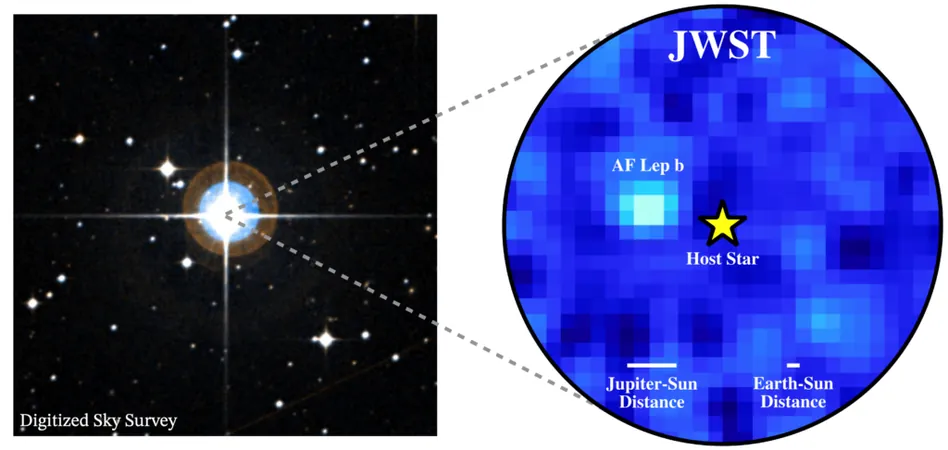
UT Astronomers Break New Ground in Exoplanet Imaging with AF Lep b Discovery!
2024-10-09
Author: Arjun
AUSTIN, Texas — In a groundbreaking achievement for the field of astronomy, planet AF Lep b has been recognized as a unique celestial body, setting multiple records in 2023.
Remarkably, it has become the lowest-mass exoplanet outside our solar system to be directly observed and its mass measured through the astrometric technique, which meticulously tracks the subtle movements of its host star over various years to reveal valuable insights about nearby planetary companions.
But that’s not all! AF Lep b has now claimed the title of the lowest-mass planet with the closest angular separation to its host star ever observed by the James Webb Space Telescope (JWST). This was documented in a recent publication in *The Astrophysical Journal Letters*, thrilling astronomers and enthusiasts alike.
At a youthful 23 million years old, AF Lep b stands in stark contrast to our Solar System's Jupiter, which is approximately 4.6 billion years old.
Its relative youth lends to its brightness, making it an ideal candidate for observation. However, graduate students Kyle Franson from The University of Texas at Austin and William Balmer from Johns Hopkins University faced a race against time to capture this fleeting opportunity as the planet edges closer to its star in its orbit.
The closer AF Lep b draws to its host star, the more challenging it becomes to observe.
“AF Lep b is on the brink of being detectable. While JWST is extraordinarily sensitive, it’s smaller than the largest ground-based telescopes, making it tough to isolate AF Lep b from its star,” Franson explained.
Unlike conventional observation techniques, JWST employs a coronagraph that blocks out the star’s light to allow for the identification of nearby celestial objects.
However, due to AF Lep b's proximity, this method obscures over 90% of the planet's light—a challenge that will only grow as it continues its orbit.
Brendan Bowler, an astronomer at UT and co-author of the study, noted, “It was assumed that JWST was better suited for detecting lower-mass planets on wider orbits, but its performance at smaller separations has been surprisingly impressive.
We're really pushing the limits of our instrumentation here!”
With an expected orbital period of 25 years around its star, there may be a possibility of capturing another image in over a decade.
To secure their window of opportunity, the research team obtained Director’s Discretionary Time—precious telescope time designated for urgent observations.
“This is quite historic as it marks the first such program led by graduate students and one of the few in the exoplanet research domain,” Bowler remarked.
The team is particularly interested in studying AF Lep b’s atmosphere, making strides in directly observing planets of similar mass to the gas giants in our solar system.
Their findings indicate an intriguing atmosphere that possesses active convection currents, mixing gaseous elements in its upper and lower layers.
Balmer noted, “We detected significantly more carbon monoxide than anticipated. This gaseous presence in the upper atmosphere suggests strong updrafts at play.”
The implications of this research go beyond AF Lep b; they forecast a future rich with possibilities for discovering and studying new exoplanets.
“These observations were made during JWST’s second operational year, and there are even more revelations on the horizon,” Bowler continued, hinting at the exciting discoveries the future holds.
Supported by the National Science Foundation, NASA, the Alfred P. Sloan Foundation, and UKRI/EPSRC, the remarkable work leverages data from the cutting-edge JWST as well as observations from the ESO telescopes at La Silla Paranal Observatory, showcasing a collaboration at the forefront of astronomical innovation.
Stay tuned for more updates—this thrilling adventure in the cosmos is only just beginning!



 Brasil (PT)
Brasil (PT)
 Canada (EN)
Canada (EN)
 Chile (ES)
Chile (ES)
 España (ES)
España (ES)
 France (FR)
France (FR)
 Hong Kong (EN)
Hong Kong (EN)
 Italia (IT)
Italia (IT)
 日本 (JA)
日本 (JA)
 Magyarország (HU)
Magyarország (HU)
 Norge (NO)
Norge (NO)
 Polska (PL)
Polska (PL)
 Schweiz (DE)
Schweiz (DE)
 Singapore (EN)
Singapore (EN)
 Sverige (SV)
Sverige (SV)
 Suomi (FI)
Suomi (FI)
 Türkiye (TR)
Türkiye (TR)